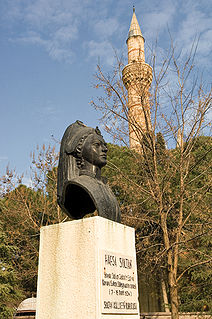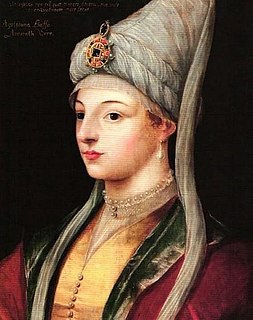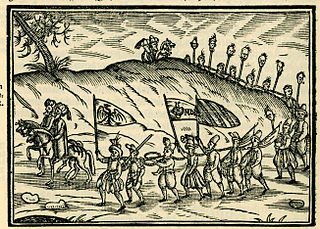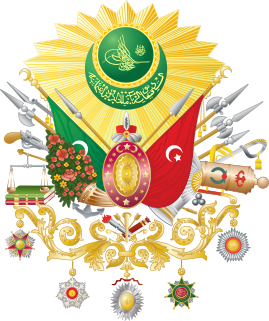
Hurrem Sultan, also known as Roxelana, was the chief consort and wife of the Ottoman sultan Suleiman the Magnificent. She became one of the most powerful and influential women in Ottoman history as well as a prominent and controversial figure during the era known as the Sultanate of Women.

An odalisque was a chambermaid or a female attendant in a Turkish seraglio, particularly the court ladies in the household of the Ottoman sultan. In western usage, the term came to mean to the harem concubine, and refers to the eroticized artistic genre in which a nominally eastern woman lies on her side on display for the spectator.

Harem properly refers to domestic spaces that are reserved for the women of the house in a Muslim family. A harem may house a man's wife or wives, their pre-pubescent male children, unmarried daughters, female domestic servants, and other unmarried female relatives. In harems of the past, concubines, which were enslaved women, were also housed in the harem. In former times some harems were guarded by eunuchs who were allowed inside. The structure of the harem and the extent of monogamy or polygamy has varied depending on the family's personalities, socio-economic status, and local customs. Similar institutions have been common in other Mediterranean and Middle Eastern civilizations, especially among royal and upper-class families, and the term is sometimes used in other contexts. In traditional Persian residential architecture the women's quarters were known as andaruni, and in the Indian subcontinent as zenana.

Valide Sultan was the title held by the "legal mother" of a ruling sultan of the Ottoman Empire. The title was first used in the 16th century for Hafsa Sultan, consort of Selim I and mother of Suleiman the Magnificent, superseding the previous title of mehd-i ulya . Normally, the living mother of a reigning sultan held this title. Those mothers who died before their sons' accession to the throne were never bestowed with the title of valide sultan. In special cases sisters, grandmothers and stepmothers of a reigning sultan assumed the title valide sultan.
Nurbanu Sultan was Haseki Sultan of the Ottoman Empire as the principal consort of Sultan Selim II, his legal wife, as well as Valide Sultan as the mother of Sultan Murad III. She was one of the most prominent figures during the time of the Sultanate of Women. Conflicting theories ascribe her a Venetian, Jewish or Greek origin. Her birth name may have been Cecilia Venier-Baffo, Rachel or Kalē Kartanou.

Safiye Sultan was the Haseki Sultan of Murad III and Valide Sultan of the Ottoman Empire as the mother of Mehmed III and the grandmother of Sultans: Ahmed I and Mustafa I. Safiye was also one of the eminent figures during the era known as the Sultanate of Women. She lived in the Ottoman Empire as a courtier during the reigns of seven sultans: Suleiman the Magnificent, Selim II, Murad III, Mehmed III, Ahmed I, Mustafa I, and Osman II.

Mahfiruz Hatun was a concubine of Ottoman Sultan Ahmed I, the mother of Sultan Osman II.

The Imperial Harem of the Ottoman Empire was the Ottoman sultan's harem – composed of the wives, servants, female relatives and the sultan's concubines – occupying a secluded portion (seraglio) of the Ottoman imperial household. This institution played an important social function within the Ottoman court, and wielded considerable political authority in Ottoman affairs, especially during the long period known as the Sultanate of Women. Multiple historians claim that the sultan was frequently lobbied by harem members of different ethnic or religious backgrounds to influence the geography of the Ottoman wars of conquest. The utmost authority in the Imperial Harem, the valide sultan, ruled over the other women in the household; the consorts of the sultan were normally of slave origin, and thus were also his mother, the valide sultan.
Ottoman court was the culture that evolved around the court of the Ottoman Empire.

Leyla Saz, also called Leyla Hanimefendi (1850–1936) was a Turkish composer, poet and writer.

Women in the Ottoman Empire enjoyed a diverse range of rights depending on the time period, as well as their religion and class. The Ottoman Empire, first as a Turkoman beylik, and then a multi-ethnic, multi-religious empire, was ruled in accordance to the qanun, the semi-secular body of law enacted by Ottoman sultans. Furthermore, the relevant religious scriptures of its many confessional communities played a major role in the legal system, for the majority of Ottoman women, these were the Quran and Hadith as interpreted by Islamic jurists, often termed sharia. Most Ottoman women were permitted to participate in the legal system, purchase and sell property, inherit and bequeath wealth, and participate in other financial activities, rights which were unusual in the rest of Europe until the 19th century.

Slavery in the Ottoman Empire was a legal and significant part of the Ottoman Empire's economy and traditional society. The main sources of slaves were wars and politically organized enslavement expeditions in Southern Europe, Eastern Europe, the Balkans, and the Caucasus. It has been reported that the selling price of slaves decreased after large military operations. In Constantinople, the administrative and political center of the Ottoman Empire, about a fifth of the 16th- and 17th-century population consisted of slaves. Customs statistics of these centuries suggest that Istanbul's additional slave imports from the Black Sea may have totaled around 2.5 million from 1453 to 1700.

Harem pants or harem trousers are baggy, long pants caught in at the ankle. Early on, the style was also called a harem skirt. The original so-called 'harem pants/skirts' were introduced to Western fashion by designers such as Paul Poiret around 1910, although they themselves were inspired by Middle East styles, and by şalvar. The term 'harem pants' subsequently became popular in the West as a generic term for baggy trousers caught in at the ankle that suggest the Turkish style, or similar styles such as bloomers, the South Asian shalwar and patiala salwar; the Bosnian dimije; sirwal ; and the Ukrainian sharovary.
Alev Lytle Croutier, known in Turkey as "Alev Aksoy Croutier", is a writer based in San Francisco, US. Her books have been translated into 22 languages. She is the author of the non-fiction books Harem: the World behind the Veil and Taking the Waters, and the novels The Palace of Tears, Seven Houses, and The Third Woman.
Esther Handali was an Jewish Ottoman businessperson. She was the influential favorite and Kira of Nurbanu Sultan, Safiye Sultan, and possibly of Hürrem Sultan.

Nurhan Atasoy is a Turkish art historian. She specializes in history of Ottoman and Islamic art. She served as a Chair in the Department of Fine Arts, Archeology and Art History at Istanbul University until 1999 when she retired. She is a resident scholar of the Turkish Cultural Foundation.

The Sultanate of Women was a period of extraordinary political influence exerted by wives and mothers of the Sultans of the Ottoman Empire. This phenomenon in the early modern period, approximately between the years 1533 and 1656, began during the reign of Suleiman the Magnificent with his marriage to Hürrem Sultan. These sultanas were either the wives of the Sultan, referred to as Haseki Sultans, or the mothers of the Sultan, known as Valide Sultans. Many of these women were of slave origins, as was expected of the sultanate, since traditional marriage roles were considered too large a risk for the Sultan, who was expected to have no personal allegiances outside his title. During this time, Haseki and Valide Sultans held political and social power, which allowed them to influence the daily running of the empire, as well as requesting the construction of buildings, and philanthropic works, such as Valide Sultan Mosque.

Cariye or Cariyes was a title and term used for category of enslaved women concubines in the Islamic world of the Middle East. They are particularly known in history from the era of the Ottoman Empire, where they legally existed until the mid-19th century.

The harem of the caliphs of the Abbasid Caliphate (750–1258) in Baghdad was composed of his mother, wives, slave concubines, female relatives and slave servants, occupying a secluded portion of the Abbasid household. This institution played an important social function within the Abbasid court and was the part of court were the women of the court were confined and secluded. The senior woman in rank in the harem was the mother of the Caliph. The Abbasid harem acted as a role model for the harems of other Islamic dynasties, as it was during the Abbasid Caliphate that the harem system was fully enforced in the Muslim world.
Nafisa al-Bayda, was the spouse of the Egyptian Mamluk leaders Ali Bey al-Kabir and Murad Bey. She has been referred to as the most famous Mamluk woman in 18th-century Egypt. She was a successful business financier and philanthropist, but is most known for her diplomatic service as the mediator between Murad Bey and the French occupation forces of Napoleon Bonaparte in 1798–1801.














